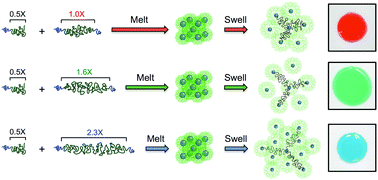Tailoring mechanical response through coronal layer overlap in tethered micelle hydrogel networks†
Abstract
Tethered micelle hydrogel networks based on the solution assembly of amphiphilic ABA-type block copolymers are prevalent throughout the hydrogel literature. However, the mechanical response of such systems is often determined largely by the integrity of the micellar core produced during solution assembly, not by the elements of the network structure upon which it is based. Using a solvent-free fabrication method based on the melt-state self-assembly of sphere-forming polystyrene-b-poly(ethylene oxide) (SO) diblock and SOS triblock copolymers blends, we have been able to produce tethered micelle hydrogel networks with fully vitrified cores that enable the elements of the network structure to determine the mechanical response. Here, we explore the impact of using PEO midblocks of different lengths within the SOS tethers, in an effort to elucidate the role played by water content, tether concentration, and tether length in mechanical property determination. In doing so, we were able to establish coronal layer overlap as the primary contributing factor in regulating the dynamic elastic moduli exhibited by tethered micelle systems. Variation of either tether concentration or tether length could be used to tune the degree of coronal layer overlap, enabling direct and accurate control over hydrogel mechanical response. While such control is likely a unique feature of the melt-state fabrication approach applied here, the conclusions with respect to the role of coronal layer overlap and tether (bridging) concentration in determining the mechanical potential of the network should be applicable to all ABA-type tethered micelle systems, regardless of fabrication methodology.


 Please wait while we load your content...
Please wait while we load your content...